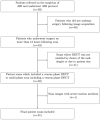Iodine density mapping for the diagnosis of acute bowel ischemia using fast kV-switching dual-energy CT
- PMID: 37978076
- PMCID: PMC10789852
- DOI: 10.1007/s00261-023-04097-4
Iodine density mapping for the diagnosis of acute bowel ischemia using fast kV-switching dual-energy CT
Abstract
Purpose: To evaluate the diagnostic capabilities of a supplementary color ramped iodine density map compared to virtual monoenergetic images (VMIs) at 74 keV in the diagnosis of acute bowel ischemia (ABI).
Methods: Data for this study were prospectively gathered and retrospectively evaluated. Patients referred to the Department of Diagnostic Radiology between October 2020 and August 2022 on the suspicion of ABI and underwent surgery < 12 h following fast kV-switching venous phase abdominal dual-energy CT (DECT) were consecutively included. Images were evaluated by two board-certified radiologists and two radiology residents. First round included only 74 keV VMIs resembling conventional 120 kVp images, and the second round included a supplementary iodine density map. Readers were asked to register presence of ABI as well as their confidence in their diagnosis based on a 5-point Likert scale. Sensitivity, specificity, positive predictive value (PPV), and negative predictive value (NPV) were calculated for each observer with the surgical findings as the gold-standard. McNemar's and Wilcoxon signed-rank test were used to compare registrations and diagnostic confidence across assessment rounds.
Results: A total of 29 patients resulting in 31 DECT scans were included. Fourteen cases of ischemic/necrotic bowel were reported following surgery. Sensitivity and NPV were decreased with the use of supplementary iodine map images compared to 120 kVp-like images without supplementary iodine map images for three of four observers (round 1 range: 71.4-92.9% and 78.0-94.8%; round 2 range: 57.1-78.6% and 70.1-83.3%, respectively), while specificity and PPV were increased for three of four observers (round 1 range: 64.7-94.1% and 67.4-93.1%; round 2 range: 88.2-94.1% and 73.8-91.1%, respectively). However, no significant difference in ABI diagnosis or diagnostic confidence was found (p-value range: 0.07-1.00 and 0.23-0.58, respectively).
Conclusion: No significant difference for the diagnosis of ABI was found using supplementary iodine mapping. Our study may suggest a trend of increased specificity and decreased sensitivity, hence, the use of supplementary iodine mapping should be carefully considered.
Keywords: Bowel ischemia; Computed tomography; Dual-energy CT.
© 2023. The Author(s).
Conflict of interest statement
The authors J.J.X. and P.S.U. have received consulting fees from GE healthcare for presenting at GE Healthcare related webinars. The other authors of this manuscript declare no relationships with any companies whose products or services may be related to the subject matter of the article.
Figures





Similar articles
-
Dual-energy CT of acute bowel ischemia-influence on diagnostic accuracy and reader confidence.Eur Radiol. 2025 Mar;35(3):1405-1414. doi: 10.1007/s00330-024-11217-1. Epub 2024 Nov 27. Eur Radiol. 2025. PMID: 39592488 Free PMC article.
-
Value of dual-energy computed tomography in the diagnosis of bowel ischemia in patients with mechanical small-bowel obstruction: a retrospective, dual-center study.Eur Radiol. 2025 May 6. doi: 10.1007/s00330-025-11635-9. Online ahead of print. Eur Radiol. 2025. PMID: 40328956
-
Dual-Energy CT Iodine Mapping and 40-keV Monoenergetic Applications in the Diagnosis of Acute Bowel Ischemia.AJR Am J Roentgenol. 2018 Sep;211(3):564-570. doi: 10.2214/AJR.18.19554. Epub 2018 Jun 21. AJR Am J Roentgenol. 2018. PMID: 29927328
-
Dual-energy CT late arterial phase iodine maps for the diagnosis of acute non-occlusive mesenteric ischemia.Radiol Med. 2024 Nov;129(11):1611-1621. doi: 10.1007/s11547-024-01898-5. Epub 2024 Oct 15. Radiol Med. 2024. PMID: 39405018 Free PMC article.
-
Dual-energy CT of acute bowel ischemia.Abdom Radiol (NY). 2022 May;47(5):1660-1683. doi: 10.1007/s00261-021-03188-4. Epub 2021 Jun 30. Abdom Radiol (NY). 2022. PMID: 34191075 Review.
Cited by
-
Dual-energy CT of acute bowel ischemia-influence on diagnostic accuracy and reader confidence.Eur Radiol. 2025 Mar;35(3):1405-1414. doi: 10.1007/s00330-024-11217-1. Epub 2024 Nov 27. Eur Radiol. 2025. PMID: 39592488 Free PMC article.
-
Diagnostic Accuracy of Dual-Energy Computed Tomography for Bowel Necrosis in Acute Abdomen With Bowel Ischemia.Cureus. 2025 Mar 23;17(3):e81057. doi: 10.7759/cureus.81057. eCollection 2025 Mar. Cureus. 2025. PMID: 40271288 Free PMC article.
-
Value of dual-energy computed tomography in the diagnosis of bowel ischemia in patients with mechanical small-bowel obstruction: a retrospective, dual-center study.Eur Radiol. 2025 May 6. doi: 10.1007/s00330-025-11635-9. Online ahead of print. Eur Radiol. 2025. PMID: 40328956
-
Diagnostic Role of Multi-Detector Computed Tomography in Acute Mesenteric Ischemia.Diagnostics (Basel). 2024 Jun 7;14(12):1214. doi: 10.3390/diagnostics14121214. Diagnostics (Basel). 2024. PMID: 38928630 Free PMC article. Review.
References
Publication types
MeSH terms
Substances
LinkOut - more resources
Full Text Sources

